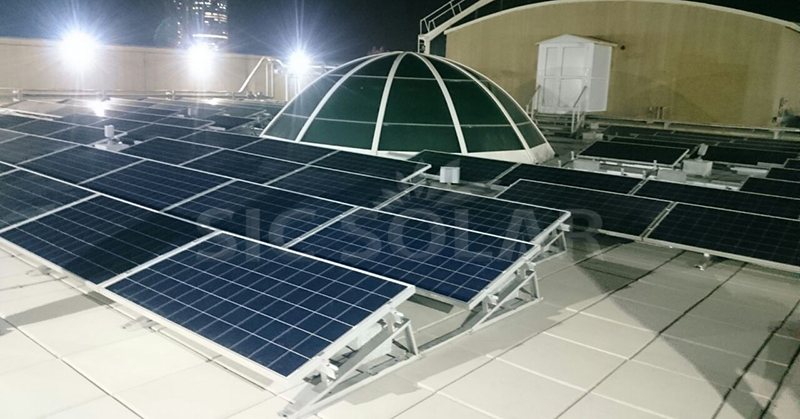Ballast installation is a widely used method of solar panel installation, especially on flat roofs, as drilling holes in the roof structure is not ideal or feasible. The system does not penetrate the roof, but relies on weighted objects or ballast to hold the solar panels in place. Ballast installation systems offer a non-invasive, flexible and effective solution for solar installations, making it a popular choice for residential, commercial and industrial projects.

The working principle of ballast installation
Ballast mounting systems use heavy materials such as concrete blocks or steel plates to counteract wind loads and other environmental forces to hold solar panels in place. These ballasts are carefully placed to ensure the stability of the system without damaging the roof surface.
Usually, the system includes:
- Mounting Frames: Designed to support solar panels at the optimum angle to generate energy.
- Ballasts: A weighted block that provides stability and prevents the panels from moving or rising due to wind.
- Protective Layers: Materials such as rubber mats are usually placed under the mounting frame to prevent damage to the roof.
Companies such as SIC Solar design lightweight and durable ballast mounting systems to adapt to different roof types and environmental conditions.
The advantages of ballast installation
- Non-Invasive Installation
Ballast systems do not require drilling or penetrating roof membranes, thus maintaining their integrity and preventing potential leaks. This feature makes them ideal for buildings with sensitive roofing materials or structures that do not support penetrating systems. - Ease of Installation
Ballast installation systems are faster and simpler to install than traditional systems, thus reducing labor costs and installation time. - Flexibility in Design
These systems can be easily adjusted or repositioned to make them suitable for rooftops with obstacles such as HVAC systems, vents, or irregular layouts. - Cost-Effective Maintenance
Since the roof remains intact, maintenance is simpler and cheaper, especially when compared to systems that require penetration. - Compatibility with Flat RoofsBallast installations are particularly effective on flat roofs because it is easier to distribute the weight evenly and position the panels for maximum energy production.
Considerations for Ballast Mounting
Although ballast systems offer many advantages, there are still a few factors to consider to ensure optimum performance:
- Weight LimitationsThe total weight of the ballast and installation system shall not exceed the load-bearing capacity of the roof. Consulting a structural engineer is essential for safety and compliance.
- Wind Load
The design must take into account the wind speed in the installation area to prevent movement or damage. SIC Solar’s aerodynamic ballast design minimizes wind resistance and provides additional stability. - Roof Drainage
The ballast system should not obstruct the drainage system or cause water accumulation, otherwise it may cause the roof to break down over time. - Tilt Angle
Ballast mounting systems typically provide a fixed tilt angle. While this simplifies the design, selecting the optimum energy production angle is critical for long-term efficiency.
Types of Ballast Mounting Systems
- Standard Ballast Systems
These are simple designs where ballast holds the frame at a predetermined angle. They are widely used due to their simplicity and cost-effectiveness. - East-West Ballast SystemsThese systems face the panels east-west instead of south. This layout minimizes inter-row shading and maximizes the day’s energy output.
- Custom Ballast Systems
Customized solutions, such as those offered by SIC Solar, can be tailored to meet specific roof types, climate and energy requirements. These systems are tailored to achieve optimum performance and efficiency.
Why Choose SIC Solar for Ballast Mounting?
SIC Solar is a leading manufacturer of photovoltaic installation systems, offering innovative solutions for flat roof solar installations. Their ballast installation systems have the following characteristics:
- Corrosion-Resistant: Made of durable materials that can withstand severe weather conditions.
- Lightweight and Stable: Designed to balance load requirements and stability.
- Easy to Install: Designed for quick assembly, reducing labor time and cost.
SIC Solar works closely with customers to provide customized solutions to ensure that each project meets its energy goals efficiently and reliably.
Applications of Ballast Mounting Systems
Ballast mounting systems are suitable for a variety of installations, including:
- Commercial and Industrial Buildings: Flat roofs for factories, warehouses, and office buildings.
- Residential Properties: For homeowners with flat or low pitched roofs.
- Temporary Installations: Ideal for situations where the system may need to be relocated or dismantled in the future.